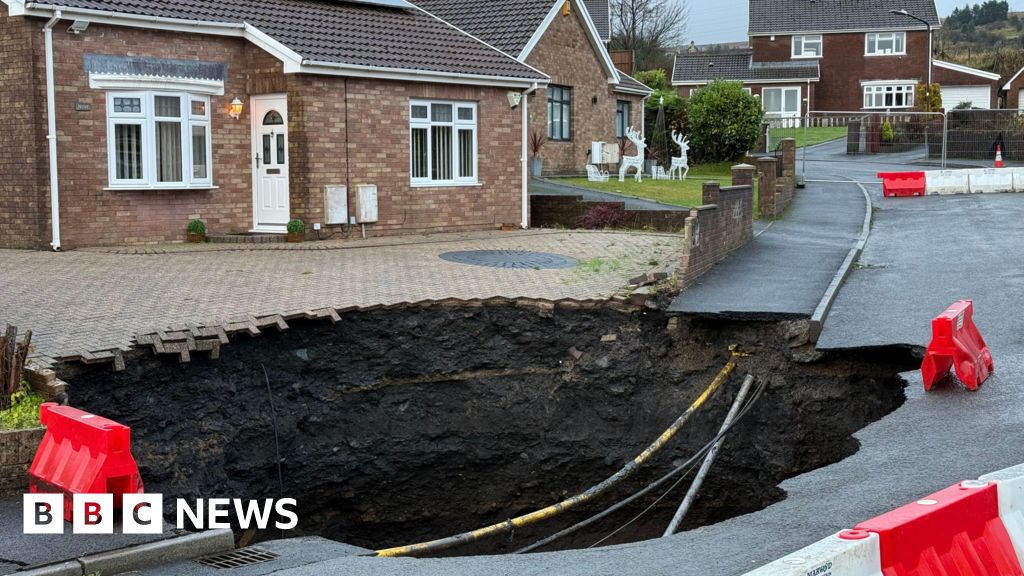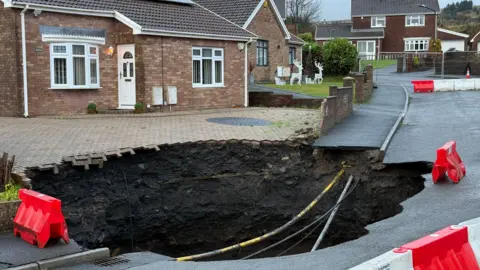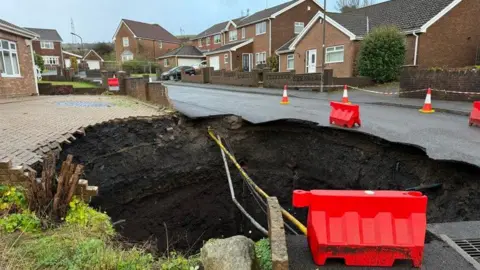
 BBC
BBCResidents evacuated from an estate where a sinkhole has appeared have spoken of their “devastation” as they face the possibility of being out of their homes for Christmas.
The sinkhole has swallowed up part of the driveway of a bungalow on Nant Morlais in Pant, Merthyr Tydfil, along with a section of pavement and road.
About 30 homes were evacuated on Sunday morning and Simon Williams, whose family owns the bungalow where the sinkhole appeared, said it could be months until residents of the cul-de-sac could safely return home.
“We do feel desperately sorry for all the residents who’ve had to get out of their homes just before Christmas,” said Mr Williams.

Merthyr Tydfil council leader Brent Carter said they could not give a date when residents would be able to return home.
Residents who had not been able to move in with relatives or friends were put into hotels by the council, he added.

Mr Williams said he and his wife were devastated by what had happened but were more concerned about their friends who currently live in the house.
He said it was “frightening to think what could have happened when they were reversing their cars off the drive”.
“They could have been injured or worse,” he said.
Mr Williams said they first learned of the sinkhole on Saturday evening, when it was about one foot (0.3 metres) wide, adding: “To be honest, we wondered if the bungalow would still be standing this morning [Monday], but it’s still standing at the moment.”

Callum Morgan said he and his partner, Niamh – a tenant at the property – had been in an AirBnB property since Sunday night and expected to stay there for a few days.
“Brick by brick she said she could see the driveway going under slowly, and at one point we thought it was going to go up to the house, but at the moment it looks like it’s stopped,” he said.
What caused the Merthyr sinkhole?
Local councillor David Hughes said the cause of the sinkhole was believed to be a collapsed culvert and the council would know more once repair work had been carried out.
He said the work would include putting block stones either side of the culvert to shore up the side of the ground, as well as fitting steel plates to stabilise it.
Hughes praised residents for moving out of their homes “without any fuss or bother”.
An excavator and four lorries loaded with boulders were seen arriving on site on Mon day morning, ready for work to begin.
What is a sinkhole?
While any large hole that opens up in the ground tends to be dubbed a sinkhole, this catch-all term is not always an accurate description.
The British Geological Survey (BGS) describes a sinkhole as “a natural surface depression caused by dissolution of soluble rocks at depth”.
Sinkholes can be formed by gradual dissolution happening underground, but they can also be caused by heavy rain or surface flooding, construction work, leaking drainage pipes, burst water mains and groundwater abstraction, the BGS said.




